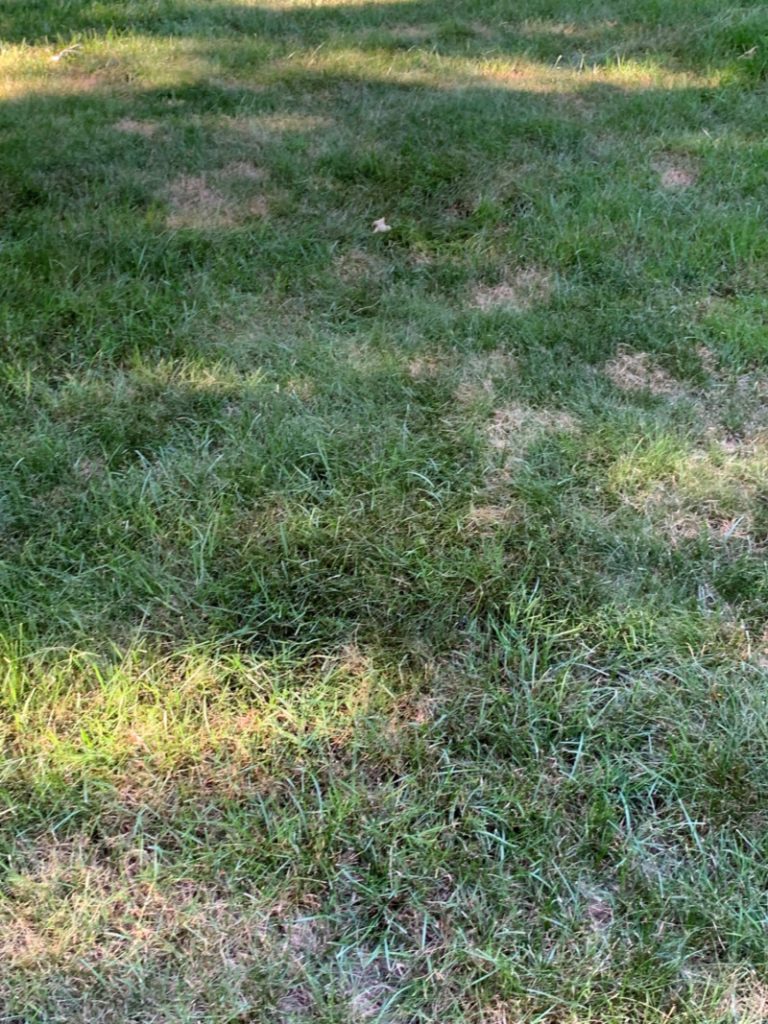In earlier blog posts, I offered tips to prevent drought stress and fungus for summer lawns. Before I talk about your lawn, let me ask you a few questions. How does your body respond when: Summer temps hit 80 degrees and begin climbing? You’re sitting at the beach and forgot to apply sunscreen? You’re out in the sun for an hour straight and forgot to bring something to drink? Well, your lawn responds the same way: It gets stressed and dehydrated and sunburned!
Most people don’t realize that proper mowing, watering, and maintenance are the key ingredients to having a lush, green lawn. No, let me amend that statement. Proper mowing, watering, and maintenance are key …. so long as Mother Nature cooperates. In reality, Mother Nature is the real boss of your lawn–she’s senior management and you and your lawn care provider are middle management.
The following images illustrate what I’ve been talking about in this and previous blog posts. I personally took these pictures at about 5:30 p.m. this evening. One of our customers gave me permission to do so, and it’s important for you to know the following about how she cares for her lawn. First, she never waters. Never. Second, she mows her entire lawn to a height of 4″ to 5″ in the summer and does NOT bag her clippings. Third, I stood in the exact, same spot to take both pictures. Picture #1 is what I saw when I looked one way. Picture #2 is what I saw when I remained in the same spot and turned 180 degrees. These two areas are immediately adjacent to each other.
Illustration

In this picture, you see nice, green grass. This section, which is just feet away from the following picture, is directly beneath two 40-year-old maple trees and receives virtually NO direct sunlight.

In this picture, you see brown spots. These are areas of fungus that have burned because this section of lawn is in direct sunlight from about 11 a.m. until 5 p.m.
As the season progresses, and as the temps continuing rising and this customer continues NOT watering her lawn, both areas will brown out. Why? Because the grass will become dehydrated and the portion of the plant above ground will suffer. It will take longer for the shady areas to brown out but, without water, it will happen. Also keep in mind this customer does not bag her grass clippings, so she’ll have more fungus in her lawn than if she bagged it. It is almost certain the fungus on her lawn will spread and continue burning. On top of all this, her location is adjacent to a wooded area and a creek, so she has higher humidity and moisture than other locations–and a lot of moss, as well. This is just another component of her fungus issue.
Review
It’s important to remember that all the moving pieces must work together to have a beautiful, lush, green lawn. It’s equally important to remember that (a) signs of drought stress do not mean your grass is dead, and (b) applying fertilizer and other chemicals to your lawn may not be the best way to repair the grass. Grass can turn brown from a number of different causes–and sometimes patience (i.e., waiting for cooler, damper weather conditions) is the best solution.
First and foremost, Mother Nature must cooperate to prevent drought stress and fungus. Then you must ensure your watering, mowing, and maintenance are appropriate for your particular location. Fertilization, lime, and other lawn applications support and enhance all that you (and Mother Nature) do. Here are some other tips.
Happy Summer!

